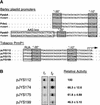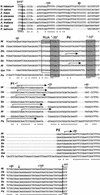Unique architecture of the plastid ribosomal RNA operon promoter recognized by the multisubunit RNA polymerase in tobacco and other higher plants
- PMID: 12509531
- PMCID: PMC143491
- DOI: 10.1105/tpc.007914
Unique architecture of the plastid ribosomal RNA operon promoter recognized by the multisubunit RNA polymerase in tobacco and other higher plants
Abstract
Expression of the plastid rRNA operon (rrn) during development is highly regulated at the level of transcription. The plastid rrn operon in most higher plants is transcribed by the plastid-encoded RNA polymerase (PEP), the multisubunit plastid RNA polymerase from PrrnP1, a sigma(70)-type promoter with conserved -10 and -35 core promoter elements. To identify functionally important sequences, the tobacco PrrnP1 was dissected in vivo and in vitro. Based on in vivo deletion analysis, sequences upstream of nucleotide -83 do not significantly contribute to promoter function. The in vitro analyses identified an essential hexameric sequence upstream of the -35 element (GTGGGA; the rRNA operon upstream activator [RUA]) that is conserved in monocot and dicot species and suggested that the -10 element plays only a limited role in PrrnP1 recognition. Mutations in the initial transcribed sequence (+9 to +14) enhanced transcription, the characteristic of strong promoters in prokaryotes. We propose that sigma interaction with the -10 element in PrrnP1 is replaced in part by direct PEP-RUA (protein-DNA) interaction or by protein-protein interaction between the PEP and an RUA binding transcription factor.
Figures







Similar articles
-
Transcription from heterologous rRNA operon promoters in chloroplasts reveals requirement for specific activating factors.Plant Physiol. 1998 Aug;117(4):1495-9. doi: 10.1104/pp.117.4.1495. Plant Physiol. 1998. PMID: 9701604 Free PMC article.
-
The two RNA polymerases encoded by the nuclear and the plastid compartments transcribe distinct groups of genes in tobacco plastids.EMBO J. 1997 Jul 1;16(13):4041-8. doi: 10.1093/emboj/16.13.4041. EMBO J. 1997. PMID: 9233813 Free PMC article.
-
Plastid transcription in the holoparasitic plant genus Cuscuta: parallel loss of the rrn16 PEP-promoter and of the rpoA and rpoB genes coding for the plastid-encoded RNA polymerase.Planta. 2003 Mar;216(5):815-23. doi: 10.1007/s00425-002-0933-z. Epub 2002 Nov 12. Planta. 2003. PMID: 12624769
-
Chloroplast RNA polymerases: Role in chloroplast biogenesis.Biochim Biophys Acta. 2015 Sep;1847(9):761-9. doi: 10.1016/j.bbabio.2015.02.004. Epub 2015 Feb 11. Biochim Biophys Acta. 2015. PMID: 25680513 Review.
-
Organellar RNA polymerases of higher plants.Int Rev Cytol. 1999;190:1-59. doi: 10.1016/s0074-7696(08)62145-2. Int Rev Cytol. 1999. PMID: 10331238 Review.
Cited by
-
Optimization of transplastomic production of hemicellulases in tobacco: effects of expression cassette configuration and tobacco cultivar used as production platform on recombinant protein yields.Biotechnol Biofuels. 2013 May 3;6(1):65. doi: 10.1186/1754-6834-6-65. Biotechnol Biofuels. 2013. PMID: 23642171 Free PMC article.
-
Eukaryotic-type plastid nucleoid protein pTAC3 is essential for transcription by the bacterial-type plastid RNA polymerase.Proc Natl Acad Sci U S A. 2012 May 8;109(19):7541-6. doi: 10.1073/pnas.1119403109. Epub 2012 Apr 23. Proc Natl Acad Sci U S A. 2012. PMID: 22529394 Free PMC article.
-
Phage-type RNA polymerase RPOTmp transcribes the rrn operon from the PC promoter at early developmental stages in Arabidopsis.Plant Physiol. 2007 Nov;145(3):712-21. doi: 10.1104/pp.107.103846. Epub 2007 Sep 20. Plant Physiol. 2007. PMID: 17885088 Free PMC article.
-
Transplastomic Tomato Plants Expressing Insect-Specific Double-Stranded RNAs: A Protocol Based on Biolistic Transformation.Methods Mol Biol. 2022;2360:235-252. doi: 10.1007/978-1-0716-1633-8_18. Methods Mol Biol. 2022. PMID: 34495519
-
The linear plastid chromosomes of maize: terminal sequences, structures, and implications for DNA replication.Curr Genet. 2016 May;62(2):431-42. doi: 10.1007/s00294-015-0548-0. Epub 2015 Dec 9. Curr Genet. 2016. PMID: 26650613
References
-
- Baumgartner, B.J., Rapp, J.C., and Mullet, J.E. (1993). Plastid genes encoding the transcription/translation apparatus are differentially transcribed early in barley (Hordeum vulgare) chloroplast development: Evidence for selective stabilization of psbA mRNA. Plant Physiol. 101, 781–791. - PMC - PubMed
Publication types
MeSH terms
Substances
LinkOut - more resources
Full Text Sources
Other Literature Sources
Miscellaneous

